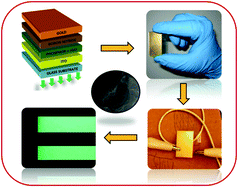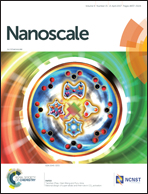A novel electroluminescent device based on a reduced graphene oxide wrapped phosphor (ZnS:Cu,Al) and hexagonal-boron nitride for high-performance luminescence†
Abstract
Reduced graphene oxide (rGO) has recently emerged as a very promising family of exotic carbon material with augmented performance in electronic and optoelectronic devices. Herein, we report an efficient and novel inorganic electroluminescent device geometry, where a new phosphor composite, reduced graphene oxide wrapped ZnS:Cu,Al, acts as an active emitting layer and an exfoliated hexagonal boron nitride (h-BN) as a dielectric layer. The roles of rGO in the active layer as a conductive support and local electric field enhancing agent are attributed to its wrinkles being unraveled compared with other carbon exotic nano-forms such as carbon nanotubes, graphite, charcoal and activated carbon, which significantly improves the brightness of the device (∼50 cd m−2 for 0.50 wt% rGO/ZnS:Cu,Al at 10 kHz and 110 V with an external quantum efficiency of ∼6.3% ± 0.1% and current efficiency of ∼0.81 ± 0.09 cd A−1). This new and facile strategy to construct the luminescent devices could be a paradigm shift towards cost effective, highly stable in air (for several days) and energy efficient next generation display devices.



 Please wait while we load your content...
Please wait while we load your content...